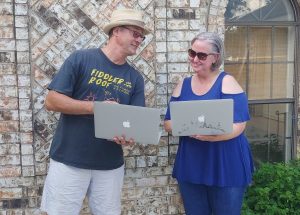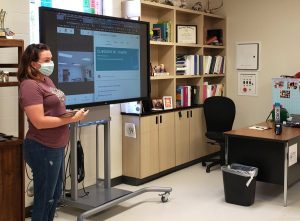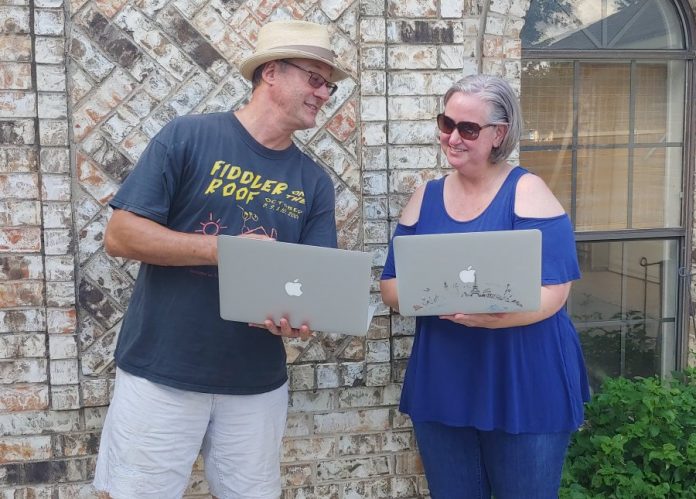
Nobody will deny that the COVID-19 pandemic is affecting the education system in ways never imagined. Whether parents decide to send their children back into the classroom or keep them at home to learn virtually, challenges abound.
But what most parents and students may not realize is the lengths to which school systems, their staffs and especially their teachers have gone this summer to best prepare everybody for what lies ahead.
The Cross Timbers Gazette talked with some of them to find out what they’ve been planning, how they will execute their plans and how they try to address the unknown. The overall results point to the innovative thinking all have done to do what they can to make the best of a battle against a foe they can’t see.
Logistics Differ Between Districts
School districts have spent the months since the spring shutdowns researching and discussing the best ways to handle the situation. There’s been a plethora of online meetings and idea sharing on social media. They listened to guidance from the Centers for Disease Control, Texas Education Association, Governor Greg Abbott and county officials and debated the various contingencies based on the ever-changing direction from those above.
Ultimately, school districts were on their own to determine which of the recommended guidelines to follow, the Lewisville ISD and Argyle ISD settled on different approaches.
Both are offering parents the choice of virtual or in-class learning with LISD having a virtual plus option for elective classes that can’t be done online. Neither is using the hybrid model of some days in-person and some online that was once discussed.
“I don’t think any of us in a million years would have dreamed on March 13 that when we walked out it would be 5-6 months later that we wouldn’t be able to walk back in,” said Jennifer Mattingly, starting her 16th year as principal at Highland Village’s McAuliffe Elementary School.
“I’m a planner and I have a lot of people who depend on me so I put together a lot of contingency plans but even with those plans there is still that hope that we can go back to school.
“While I was still planning for the what-ifs, I was hoping and praying we could go back. Even though I was very prepared when they said we’re going to go remote the first couple of weeks it was a gut-punch because it all came to light that we really aren’t.”
To help parents make their decisions, districts have distributed templates of how schedules will work in each scenario. Some teachers and administrators have produced videos and even conducted Facebook live chats to help parents understand the challenges of each option with the goal of making parents comfortable with whatever decision they make.
“We’re ready. We’re going to do a fabulous job of it,” Mattingly said. “We’re so much more prepared for the fall than we were in the spring. We’ve learned so much. I think we spent so many hours just reading and getting involved in so many social media groups with educators who were working together and bombarding ourselves with how we can get better. I know that will have a huge impact on our families and our students this fall.”
School facilities will follow appropriate safety measures including wearing masks, physical distancing options like alternating desks and plastic tri-fold barriers, frequent cleaning of classrooms and plenty of hand sanitizer and wipes to wash hands and surfaces. Interestingly, some of these measures have been employed before during the H1N1 flu outbreak of 2009.
Students will stay with their initial option at least through the first grading period. Whichever option parents choose will determine how many teachers will be needed in each area with teachers told to prepare for both.
LISD has moved all classes online from Aug. 19 until Sept. 8 with remote instruction from their in-class teacher where those students will have the same teacher throughout. Meanwhile, Argyle is starting in-class teaching right away on Aug. 17. Virtual students will learn through a combination of synchronous (live or in-person classes) vs. asynchronous (prerecorded video lessons that can be viewed at any time).
“This will look different than it did in the spring,” said Flower Mound resident Kristin Strange, an LISD special education transition life skills specialist who supports middle school and high school teachers helping juniors and seniors decide their futures. “[Last spring] we were just trying to get through the end of the year and everybody finished. Now virtual will be a full day. Families who choose virtual will have a structured full day of learning.”
It’s All About Technology, Testing and Training

Never in educational history has technology been so important with the growth of virtual learning. The biggest factor is if students have internet availability and computers at their homes.
“The first thing we did when this happened in the spring was call them to make sure they were all right,” said Flower Mound resident Les Dodson, a special education math teacher at Lewisville High School. “We were concerned for their wellbeing including ‘are you OK? Is there anything you need like free meals’ and all that. We then asked questions about technology – ‘do you have Wi-Fi? If not, we gave them information about a low-cost solution. It wouldn’t completely fix their problem but move them in the right direction. And ‘do you have an iPad.’ If they had that they were good.”
In the education world, the testing and tracing of those who might have the virus is replaced with testing and training of teachers to learn the technologies of the virtual world.
Deserae Good and Morgan Gumbert know this better than anybody. Besides their regular teaching duties at Argyle High School and Argyle Intermediate School, respectively, they serve as technology campus trainers. Already comfortable with what they need, they help teachers set up their computers, students master theirs and serve as the eyes and ears in the classroom.
“During quarantine in the spring, I was in contact with our technology team and we tested out live video casting,” said Good, an AP dual credit biology teacher. “We ended up going with a product called Cisco WebEx. We’ve had issues with it here and there because everyone’s on it.
“Spring helped us understand what worked and didn’t work in a virtual world so we also added something called Google Meet.”
Being a Google district, Argyle students use the Google Chromebooks which include the Google Classroom educational application. LISD uses Mac Books on iPads which have built-in webcams and includes the Canvas learning management system to streamline the process of sharing files. Platforms like WebEx and Google Meet allow lessons to be shared on the screen.
“A lot of our teachers who have been resisting to learn about technology have gotten over their fear and you’ll probably see more teachers using Canvas that weren’t before,” Dodson said. “When this all started one of my goals when this all started was to learn about Canvas. It wasn’t something we were typically using in the classroom very much but I set the goal to learn it about and teach others about it who were not familiar with it for things like how to make and upload their assignments.”
The Argyle ISD is purchasing webcams for every teacher to attach them to the in-room television monitor or video board. Teachers and students can click on to their Google Meet link and be joined together. Argyle High School teachers will use the webcams to broadcast lecture style classes to students at home at the same time as those in the class.
“The term that gets thrown out a lot is equal educational opportunity,” Good said. “That’s what the situation with quarantine definitely made the paradigm shift in your way of thinking in terms of how you present, how you teach, how you interact. So in the forefront is the educational opportunity needs to be as equal as possible. So live casting a student in is the first step we can do to keep it equal. They can talk, we can talk, they can ask questions just like in class.
Good said if virtual students don’t seem to be engaging and need to be disciplined, teachers can remove them from the meeting and have them view the recording later.
Good and Gumbert spent much of the spring and summer researching options and creating spreadsheets and websites with available resources related to webcams, online notes, testing, whiteboards, discussions, etc. with links and answers to frequently asked questions for teachers to access. Gumbert created a training website so teachers can learn about the Pear Deck and Near Pod interactive programs that students can use. Good even used her son’s student accounts to help test things.
“You are asking teachers to multi-task more than they ever have,” Good said.
Gumbert said using the technology actually saves teachers time and allows them to be more interactive with more students. But understanding the frustration teachers who have not used such technology have felt, plenty of training and role-playing was offered in early August on things like setting up lesson plans and assigning homework digitally. The key has been to get teachers comfortable with the new technology, a level that once they reach makes students comfortable and more confident.
But teachers like Gumbert face other challenges than those in high school.
“Elementary students are different because they are not as self-sufficient,” said Gumbert, who is in her third year teaching fourth grade math and science. “We also rely on the parent buy-in as to whether virtual learning will be as successful because they have to make sure the kid gets on. If they don’t get on, the instruction doesn’t happen.
“And the expectations of the parents can be different. The only thing we can do is build the relationships with the kids. If the kid knows you care about them they’ll do anything for you. They just want to please grown-ups but only those they feel a connection with.”
Just three years removed from earning her Master’s degree in Educational Technology at Oklahoma State University, Gumbert is more attuned to the latest technology than many of her older peers and thus will be teaching virtually this year.
“I had to create an online course in college so when we went remote it wasn’t a huge problem for me only because I have had this in the past,” said Gumbert, whose mother Anita is the technology trainer and math specialist at Hilltop Elementary. “It wasn’t much of a transition for me as I already was using a lot of the technology tools in my instruction.”
Adapting, Flexibility and Nimble is Key to Success
Even in-class learning will be different, including how students work together on group projects since materials like books and papers can’t be shared. Those teachers will be using more virtual methods to share information with their students. In fact, some teachers will be more guides than hands-on as in the past to protect themselves and their students. They will create modules and demonstration videos for students to view.
“We’re trying to have as little contact as possible,” Gumbert said.
“All have Google Chromebooks. One person has a Google Doc that they can share. Everyone is on the same Google Doc and everyone is typing and building their vocabulary list all together on this virtual piece of paper,” Good said.
“We’re going to have to react depending on what the situation is,” Strange said. “We’re all going to have to be flexible, follow along and make it work. But we got a lot of guidance and planning on what went into it for the fall.”
The challenge when dealing with younger kids is to make sure there’s a good relationship with the parents.
“Some people are going to have to get past that ‘oh my gosh, I just can’t do this’ because it’s harder,” Mattingly said. “Every one of my parents can do this. It’s just going to look different from household to household and from kid to kid.”
Virtual teaching also changes the nature of the relationships between students and their teachers. While teachers know their previous students well, new ones who are on the virtual platform can’t be easily connected. And where teachers can sense issues in-person, it’s much harder to know what might be troubling the student online.
Kids Best Learn in Different Ways
It’s no secret children don’t thrive in the educational system in the same way. Whereas some are best in classroom settings, others shine more at home. The question is can a student be in a class without automatically having to sit in the class whether at home or in a library of somewhere else?
“Some kids learn better digitally. The classroom atmosphere is not conducive for them,” Good said. “Synchronous and asynchronous learning is just that. Those kids are here, they are just not in class.”
Kids who have trouble with their peers finding out they are struggling fare much better in a virtual setting than in class including being more apt to participate and take risks.
“I really think virtual instruction will stick around because there a few kids in my class who perform a lot better virtually than in-person because they didn’t have to compare themselves to their classmates,” Gumbert said. “They feel more comfortable asking questions because nobody else knows they are asking questions. That opens up a whole new door. It gives them a new sense of pride they might not have had. They get so excited when you take the time to help them because they’ve never asked for help before. Watching that confidence grow is one of the coolest parts of virtual teaching.”
“Kids learn in all different ways and this is going to give us another tool in our tool belt to reach those kids and it may be a different level of engagement, a different level of opportunity, of creativity,” Mattingly said. “We’re going to have more tools because we’ve expanded the way that we think and the way we approach problems and solutions.”
Districts like Lewisville and Argyle have talked about future ideas like the blended classroom and COVID-19 has pushed the envelope on such a concept.
“The education system has definitely needed a little bit of a change,” said Good, who is willing to be among the guinea pigs to test the options for the future with the goal to find the best ways to educate the students even in non-traditional ways.
“I’m more the kind of guy who likes to get in there with the student. Sometimes I pick up the pen while working and I’m not going to be able to do that anymore,” Dodson said. “I’m going to have to stay in my own space and back off a little bit and maybe do more on the board.”
Future Education Will Benefit
Despite all the bad associated with the pandemic, there’s a whole bunch of good that will surface when it’s finally under control.
“I think there will be a lot of positive things that come from this,” Mattingly said. “It’s challenged us to think differently. It’s given us the opportunity to be creative and I think we’re going to learn a lot from this.
“I know I’ve already learned so much and I know there’s so much more out there to learn to make us better and I think schools are adding another dimension to their teaching and I think we’re going to be able to reach kiddos whether they’re sick or homebound or out of school. We’re going to have the tools and concepts in place to be able to serve them even though they can’t be right there in the classroom.”
For example, Good was able to find several good scientific lab demonstrations she would not have otherwise sought which gave her time to think of questions and manipulate simulations. There also are new ways to teach through various social media including videos and sites like TikTok.
“The nice thing about the push for virtual instruction now is that a lot of educational technology companies have been blowing up my email with new instructional tools they offer,” Gumbert said. “After the tech team checks them out we can instruct the other teachers about them.
“A lot of the technology tools available for virtual instruction have so many built-in adaptations that you can use to accommodate all different types of learning. I think teachers will realize ‘if I use this I only have to click a button and it ranks the kids.’ There’s a lot of accessibility features for virtual teaching you don’t have with in-person learning. They will say ‘oh my gosh, this is revolutionary.”
While dramatic change certainly can be initially uncomfortable, not changing can be even worse.
“The key is we have to provide a safe environment for our kiddos to fail because they’re not going to be correct every single time,” Mattingly said. “Just like we have to provide the same environment for our teachers to struggle through something knowing that they are supported. I think that we’re fortunate in LISD to have an administration that allows us those opportunities to learn through something. We don’t have to do it perfectly but we’re rewarded and appreciated for the effort.”
When the virus is behind us hopefully sometime in the 2020-2021 school year, it’s pretty certain everything will not return to the previous normal.
“I think there’s no going back to the way it was before this,” Gumbert said. “We might adapt some parts back but I think virtual instruction allows kids to be more independent which is what everyone wants. And it will benefit teachers as well. There will be an adjustment period that will be bumpy but after that they will see it is more rewarding than what they used to use.”











 GIF.gif)





